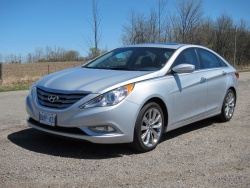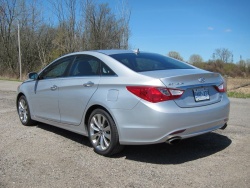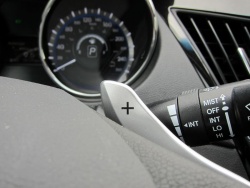 2011 Hyundai Sonata 2.0T Limited with Navigation. Click image to enlarge |
|
More Hyundai Sonata reviews on Autos.ca
Manufacturer’s web site |
Review and photos by Jil McIntosh
Photo Gallery:
2011 Hyundai Sonata 2.0T
It doesn’t seem all that long ago that Hyundai was just one more car on buyers’ “let’s check it out” list. These days it’s likely to be very close if not at the top of many lists. In recent years, the Korean automaker has sent out several top-notch offerings, including its redesigned-for-2011 Sonata.
In an unusual move, Hyundai sent the Sonata’s V6 engine packing, and for 2011 offers only four-cylinder powerplants. The three choices are a 2.4-litre, the 2.4 with hybrid system, and my tester, the 2.0T – a 2.0-litre direct-injection four-cylinder with twin-scroll turbocharger. Having driven all three, I’d suggest that it’s a rare driver who wouldn’t be able to find one that fits the bill and would still insist on those extra two pistons.
The 2.0T spins out an impressive 274 horsepower and 269 lb.-ft. of torque, that latter number peaking at just 1,800 rpm. By comparison, the 2.4-litre makes 198 horses and 184 lb.-ft., while the hybrid maximizes at 209 horses when gas engine and electric motor are making their music together. A six-speed automatic is the default transmission, which means that purists won’t be happy (and I would have loved to have tried this forced-air engine with a stick shift). My tester, the top-line 2.0T Limited with Navigation, was $33,499 (the price has risen by $700 for the 2012 model). That puts the 2011 between the 2.4-litre Sonata, which ranges from $22,699 to $31,699, and the Hybrid, which clocks in from $29,999 to $34,499.
  2011 Hyundai Sonata 2.0T Limited with Navigation. Click image to enlarge |
Turbocharging is becoming a popular option with several automakers, since it can potentially offer the best of both worlds: regular four-cylinder fuel economy when you’re light on the pedal, and V6- or even V8-style power on tap when it’s needed. The difference can be considerable: the 2.0T has more power than the V6 versions of the Chevrolet Malibu, Toyota Camry, Honda Accord or Nissan Altima, but with better fuel economy. It’s officially rated at 9.3 L/100 km (30 mpg Imp) in the city and 6.0 (47) on the highway. In combined, cooler-weather driving, I averaged 9.8 (29). The engine runs on regular-grade gasoline.
The numbers aside, the 2.0T is really sweet. The engine puts out an astonishing 137 horsepower per litre – per litre! – but do not expect to find some wild-eyed, adrenaline-soaked monster peering out from behind the grille. Acceleration is linear, and it moves out smoothly and with no throttle twitchiness when you’re gently negotiating city traffic. Ask it to step out, and there’s not a hint of turbo lag, primarily due to the twin-scroll design and the direct injection. It doesn’t feel like driving a turbo, not if you cut your teeth on those of days gone by when you hit the throttle, ate your breakfast and finished the crossword puzzle, and then felt the power kick in. It’s also very quiet, and even under hard acceleration, there’s virtually no torque-steer.
There’s a manual shift mode on the six-speed automatic, operated via the gearshift lever or by paddles mounted on the steering wheel. They’re the right type, as in there’s downshift on the left and upshift on the right, rather than redundant push-pull levers. Should you be more into wallet-watching mode at the gas pumps, there’s also an “Eco” button. It takes the edge off the throttle response, but it’s not entirely a driving-fun downer, with less buttoning-down as you find in some other companies’ systems. I don’t expect too many people to slide their fingers over that way, in any case; if you want a more sedate version, buy the 2.4-litre, which is a fine model on its own.











